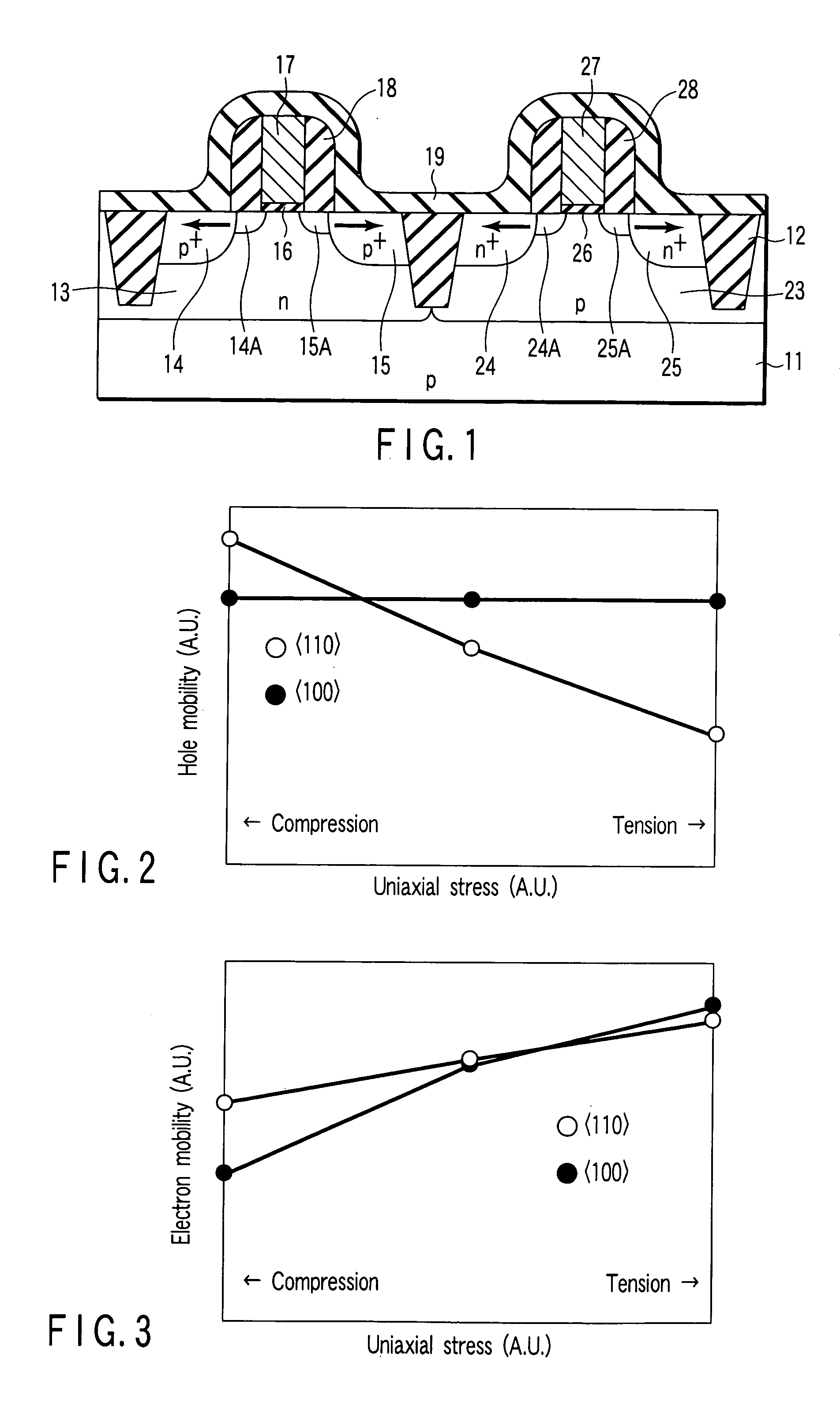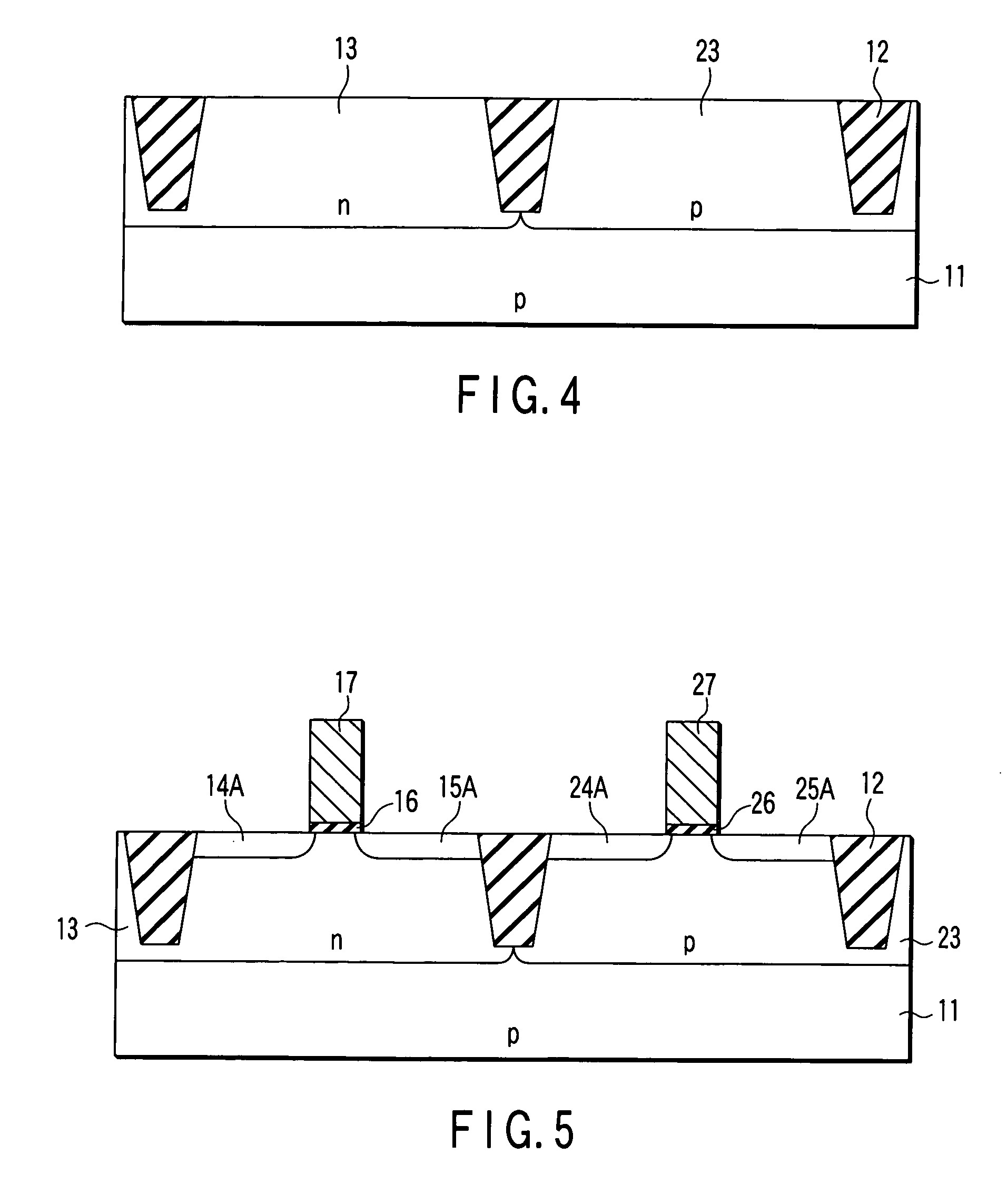Semiconductor device including field-effect transistor
a field-effect transistor and semiconductor technology, applied in the direction of semiconductor devices, basic electric elements, electrical equipment, etc., can solve the problems of increasing the circuit design effort, affecting the process, and unable to use conventional circuit design
- Summary
- Abstract
- Description
- Claims
- Application Information
AI Technical Summary
Benefits of technology
Problems solved by technology
Method used
Image
Examples
first embodiment
[0031] First, a pMOS transistor and nMOS transistor included in a semiconductor device of a first embodiment of the present invention will be explained.
[0032]FIG. 1 is a sectional view showing the structure of the semiconductor device of the first embodiment.
[0033] Element isolation regions 12 are arranged in a p-type silicon substrate 11. The p-type semiconductor substrate 11 is a (001) wafer. The element isolation regions 12 are made of, e.g., shallow trench isolation (STI) in which a silicon oxide film or the like is buried in trenches formed in the p-type semiconductor substrate 11. The element isolation regions 12 electrically insulate and isolate elements (transistors) formed on the p-type semiconductor substrate 11, thereby defining element regions where these elements are formed.
[0034] The structure of a pMOS transistor will be described below.
[0035] An n-type well region 13 is formed on the p-type silicon semiconductor substrate 11. In the surface region of the n-type w...
second embodiment
[0051] A pMOS transistor and nMOS transistor included in a semiconductor device of a second embodiment of the present invention will be described below. The same reference numerals as in the structure of the first embodiment denote the same parts, so an explanation thereof will be omitted, and only different portions will be described below.
[0052]FIG. 7 is a sectional view showing the structure of the semiconductor device of the second embodiment.
[0053] Element isolation regions formed by STI are arranged in an n-type well region 13 and p-type well region 23 on a p-type silicon semiconductor substrate 11. This STI is obtained by burying a silicon nitride film 12A and silicon oxide film 12B in trenches formed in the semiconductor substrate 11 or in the n-type well region 13 and p-type well region 23. The STI has the following structure. The trenches are formed in the p-type silicon semiconductor substrate 11, and the silicon nitride film 12A is formed on those inner surfaces of the...
third embodiment
[0061] A PMOS transistor and nMOS transistor included in a semiconductor device of a third embodiment of the present invention will be described below. The same reference numerals as in the structure of the first embodiment denote the same parts, so an explanation thereof will be omitted, and only different portions will be described below.
[0062]FIG. 10 is a sectional view showing the structure of the semiconductor device of the third embodiment.
[0063] A gate insulating film 16 is formed on an n-type well region 13 between a source region 14 and drain region 15, and a gate electrode 29 is formed on the gate insulating film 16. Also, a gate insulating film 26 is formed on a p-type well region 23 between a source region 24 and drain region 25, and a gate electrode 30 is formed on the gate insulating film 26.
[0064] The gate electrodes 29 and 30 are made of, e.g., polysilicon. A predetermined impurity (e.g., arsenic [As] or germanium [Ge]) by which this polysilicon expands upon annea...
PUM
 Login to View More
Login to View More Abstract
Description
Claims
Application Information
 Login to View More
Login to View More - R&D
- Intellectual Property
- Life Sciences
- Materials
- Tech Scout
- Unparalleled Data Quality
- Higher Quality Content
- 60% Fewer Hallucinations
Browse by: Latest US Patents, China's latest patents, Technical Efficacy Thesaurus, Application Domain, Technology Topic, Popular Technical Reports.
© 2025 PatSnap. All rights reserved.Legal|Privacy policy|Modern Slavery Act Transparency Statement|Sitemap|About US| Contact US: help@patsnap.com



